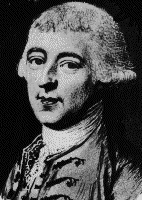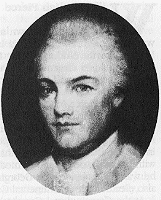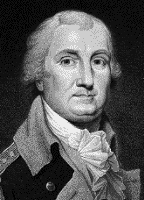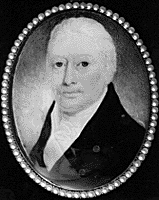
Image: National Archives, Records of Exposition, Anniversary,
and Memorial Commissions
(148-CCD-81a)
One of the most aristocratic delegates at the convention, Butler was born in 1744 in County Carlow, Ireland. His father was Sir Richard Butler, member of Parliament and a baronet.
Like so many younger sons of the British aristocracy who could not inherit their fathers' estates because of primogeniture, Butler pursued a military career. He became a major in His Majesty's 29th Regiment and during the colonial unrest was posted to Boston in 1768 to quell disturbances there. In 1771 he married Mary Middleton, daughter of a wealthy South Carolinian, and before long resigned his commission to take up a planter's life in the Charleston area. The couple was to have at least one daughter.
When the Revolution broke out, Butler took up the Whig cause. He was elected to the assembly in 1778, and the next year he served as adjutant general in the South Carolina militia. While in the legislature through most of the 1780s, he took over leadership of the democratic upcountry faction in the state and refused to support his own planter group. The War for Independence cost him much of his property, and his finances were so precarious for a time that he was forced to travel to Amsterdam to seek a personal loan. In 1786 the assembly appointed him to a commission charged with settling a state boundary dispute.
The next year, Butler won election to both the Continental Congress (1787-88) and the Constitutional Convention. In the latter assembly, he was an outspoken nationalist who attended practically every session and was a key spokesman for the Madison-Wilson caucus. Butler also supported the interests of southern slaveholders. He served on the Committee on Postponed Matters.
On his return to South Carolina Butler defended the Constitution but did not participate in the ratifying convention. Service in the U.S. Senate (1789-96) followed. Although nominally a Federalist, he often crossed party lines. He supported Hamilton's fiscal program but opposed Jay's Treaty and Federalist judiciary and tariff measures.
Out of the Senate and back in South Carolina from 1797 to 1802, Butler was considered for but did not attain the governorship. He sat briefly in the Senate again in 1803-4 to fill out an unexpired term, and he once again demonstrated party independence. But, for the most part, his later career was spent as a wealthy planter. In his last years, he moved to Philadelphia, apparently to be near a daughter who had married a local physician. Butler died there in 1822 at the age of 77 and was buried in the yard of Christ Church.

Image: National Archives, Records of Exposition, Anniversary,
and Memorial Commissions
(148-CCD-54)
Charles Pinckney, the second cousin of fellow-signer Charles Cotesworth Pinckney, was born at Charleston, SC, in 1757. His father, Col. Charles Pinckney, was a rich lawyer and planter, who on his death in 1782 was to bequeath Snee Farm, a country estate outside the city, to his son Charles. The latter apparently received all his education in the city of his birth, and he started to practice law there in 1779.
About that time, well after the War for Independence had begun, young Pinckney enlisted in the militia, though his father demonstrated ambivalence about the Revolution. He became a lieutenant, and served at the siege of Savannah (September-October 1779). When Charleston fell to the British the next year, the youth was captured and remained a prisoner until June 1781.
Pinckney had also begun a political career, serving in the Continental Congress (1777-78 and 1784-87) and in the state legislature (1779-80, 1786-89, and 1792-96). A nationalist, he worked hard in Congress to ensure that the United States would receive navigation rights to the Mississippi and to strengthen congressional power.
Pinckney's role in the Constitutional Convention is controversial. Although one of the youngest delegates, he later claimed to have been the most influential one and contended he had submitted a draft that was the basis of the final Constitution. Most historians have rejected this assertion. They do, however, recognize that he ranked among the leaders. He attended full time, spoke often and effectively, and contributed immensely to the final draft and to the resolution of problems that arose during the debates. He also worked for ratification in South Carolina (1788). That same year, he married Mary Eleanor Laurens, daughter of a wealthy and politically powerful South Carolina merchant; she was to bear at least three children.
Subsequently, Pinckney's career blossomed. From 1789 to 1792 he held the governorship of South Carolina, and in 1790 chaired the state constitutional convention. During this period, he became associated with the Federalist Party, in which he and his cousin Charles Cotesworth Pinckney were leaders. But, with the passage of time, the former's views began to change. In 1795 he attacked the Federalist backed Jay's Treaty and increasingly began to cast his lot with Carolina back-country Democratic-Republicans against his own eastern aristocracy. In 1796 he became governor once again, and in 1798 his Democratic-Republican supporters helped him win a seat in the U.S. Senate. There, he bitterly opposed his former party, and in the presidential election of 1800 served as Thomas Jefferson's campaign manager in South Carolina.
The victorious Jefferson appointed Pinckney as Minister to Spain (1801-5), in which capacity he struggled valiantly but unsuccessfully to win cession of the Floridas to the United States and facilitated Spanish acquiescence in the transfer of Louisiana from France to the United States in 1803.
Upon completion of his diplomatic mission, his ideas moving ever closer to democracy, Pinckney headed back to Charleston and to leadership of the state Democratic-Republican Party. He sat in the legislature in 1805-6 and then was again elected as governor (1806-8). In this position, he favored legislative reapportionment, giving better representation to back-country districts, and advocated universal white manhood suffrage. He served again in the legislature from 1810 to 1814 and then temporarily withdrew from politics. In 1818 he won election to the U.S. House of Representatives, where he fought against the Missouri Compromise.
In 1821, Pinckney's health beginning to fail, he retired for the last time from politics. He died in 1824, just 3 days after his 67th birthday. He was laid to rest in Charleston at St. Philip's Episcopal Churchyard.

Image: National Portrait Gallery, Smithsonian Institution
The eldest son of a politically prominent planter and a remarkable mother who introduced and promoted indigo culture in South Carolina, Charles Cotesworth Pinckney was born in 1746 at Charleston. Only 7 years later, he accompanied his father, who had been appointed colonial agent for South Carolina, to England. As a result, the youth enjoyed a European education.
Pinckney received tutoring in London, attended several preparatory schools, and went on to Christ Church College, Oxford, where he heard the lectures of the legal authority Sir William Blackstone and graduated in 1764. Pinckney next pursued legal training at London's Middle Temple and was accepted for admission into the English bar in 1769. He then spent part of a year touring Europe and studying chemistry, military science, and botany under leading authorities.
Late in 1769, Pinckney sailed home and the next year entered practice in South Carolina. His political career began in 1769, when he was elected to the provincial assembly. In 1773 he acted as attorney general for several towns in the colony. By 1775 he had identified with the patriot cause and that year sat in the provincial congress. Then, the next year, he was elected to the local committee of safety and made chairman of a committee that drew up a plan for the interim government of South Carolina.
When hostilities broke out, Pinckney, who had been a royal militia officer since 1769, pursued a full-time military calling. When South Carolina organized its forces in 1775, he joined the First South Carolina Regiment as a captain. He soon rose to the rank of colonel and fought in the South in defense of Charleston and in the North at the Battles of Brandywine, PA, and Germantown, PA. He commanded a regiment in the campaign against the British in the Floridas in 1778 and at the siege of Savannah. When Charleston fell in 1780, he was taken prisoner and held until 1782. The following year, he was discharged as a brevet brigadier general.
After the war, Pinckney resumed his legal practice and the management of estates in the Charleston area but found time to continue his public service, which during the war had included tours in the lower house of the state legislature (1778 and 1782) and the senate (1779).
Pinckney was one of the leaders at the Constitutional Convention. Present at all the sessions, he strongly advocated a powerful national government. His proposal that senators should serve without pay was not adopted, but he exerted influence in such matters as the power of the Senate to ratify treaties and the compromise that was reached concerning abolition of the international slave trade. After the convention, he defended the Constitution in South Carolina.
Under the new government, Pinckney became a devoted Federalist. Between 1789 and 1795 he declined presidential offers to command the U.S. Army and to serve on the Supreme Court and as Secretary of War and Secretary of State. In 1796, however, he accepted the post of Minister to France, but the revolutionary regime there refused to receive him and he was forced to proceed to the Netherlands. The next year, though, he returned to France when he was appointed to a special mission to restore relations with that country. During the ensuing XYZ affair, refusing to pay a bribe suggested by a French agent to facilitate negotiations, he was said to have replied "No! No! Not a sixpence!"
When Pinckney arrived back in the United States in 1798, he found the country preparing for war with France. That year, he was appointed as a major general in command of American forces in the South and served in that capacity until 1800, when the threat of war ended. That year, he represented the Federalists as Vice-Presidential candidate, and in 1804 and 1808 as the Presidential nominee. But he met defeat on all three occasions.
For the rest of his life, Pinckney engaged in legal practice, served at times in the legislature, and engaged in philanthropic activities. He was a charter member of the board of trustees of South Carolina College (later the University of South Carolina), first president of the Charleston Bible Society, and chief executive of the Charleston Library Society. He also gained prominence in the Society of the Cincinnati, an organization of former officers of the War for Independence.
During the later period of his life, Pinckney enjoyed his Belmont estate and Charleston high society. He was twice married; first to Sarah Middleton in 1773 and after her death to Mary Stead in 1786. Survived by three daughters, he died in Charleston in 1825 at the age of 79. He was interred there in the cemetery at St. Michael's Episcopal Church.

Image: The J.B. Speed Art Museum
John Rutledge, elder brother of Edward Rutledge, signer of the Declaration of Independence, was born into a large family at or near Charleston, SC, in 1739. He received his early education from his father, an Irish immigrant and physician, and from an Anglican minister and a tutor. After studying law at London's Middle Temple in 1760, he was admitted to English practice. But, almost at once, he sailed back to Charleston to begin a fruitful legal career and to amass a fortune in plantations and slaves. Three years later, he married Elizabeth Grimke, who eventually bore him 10 children, and moved into a townhouse, where he resided most of the remainder of his life.
In 1761 Rutledge became politically active. That year, on behalf of Christ Church Parish, he was elected to the provincial assembly and held his seat until the War for Independence. For 10 months in 1764 he temporarily held the post of provincial attorney general. When the troubles with Great Britain intensified about the time of the Stamp Act in 1765, Rutledge, who hoped to ensure continued self-government for the colonies, sought to avoid severance from the British and maintained a restrained stance. He did, however, chair a committee of the Stamp Act Congress that drew up a petition to the House of Lords.
In 1774 Rutledge was sent to the First Continental Congress, where he pursued a moderate course. After spending the next year in the Second Continental Congress, he returned to South Carolina and helped reorganize its government. In 1776 he served on the committee of safety and took part in the writing of the state constitution. That year, he also became president of the lower house of the legislature, a post he held until 1778. During this period, the new government met many stern tests.
In 1778 the conservative Rutledge, disapproving of democratic revisions in the state constitution, resigned his position. The next year, however, he was elected as governor. It was a difficult time. The British were invading South Carolina, and the military situation was desperate. Early in 1780, by which time the legislature had adjourned, Charleston was besieged. In May it fell, the American army was captured, and the British confiscated Rutledge's property. He ultimately escaped to North Carolina and set about attempting to rally forces to recover South Carolina. In 1781, aided by Gen. Nathanael Greene and a new Continental Army force, he reestablished the government. In January 1782 he resigned the governorship and took a seat in the lower house of the legislature. He never recouped the financial losses he suffered during the war.
In 1782-83 Rutledge was a delegate to the Continental Congress. He next sat on the state chancery court (1784) and again in the lower house of the legislature (1784-90). One of the most influential delegates at the Constitutional Convention, where he maintained a moderate nationalist stance and chaired the Committee of Detail, he attended all the sessions, spoke often and effectively, and served on five committees. Like his fellow South Carolina delegates, he vigorously advocated southern interests.
The new government under the Constitution soon lured Rutledge. He was a Presidential elector in 1789 and Washington then appointed him as Associate Justice of the U.S. Supreme Court, but for some reason he apparently served only a short time. In 1791 he became chief justice of the South Carolina supreme court. Four years later, Washington again appointed him to the U.S. Supreme Court, this time as Chief Justice to replace John Jay. But Rutledge's outspoken opposition to Jay's Treaty (1794), and the intermittent mental illness he had suffered from since the death of his wife in 1792, caused the Federalist-dominated Senate to reject his appointment and end his public career. Meantime, however, he had presided over one term of the Court.
Rutledge died in 1800 at the age of 60 and was interred at St.
Michael's Episcopal Church in Charleston.